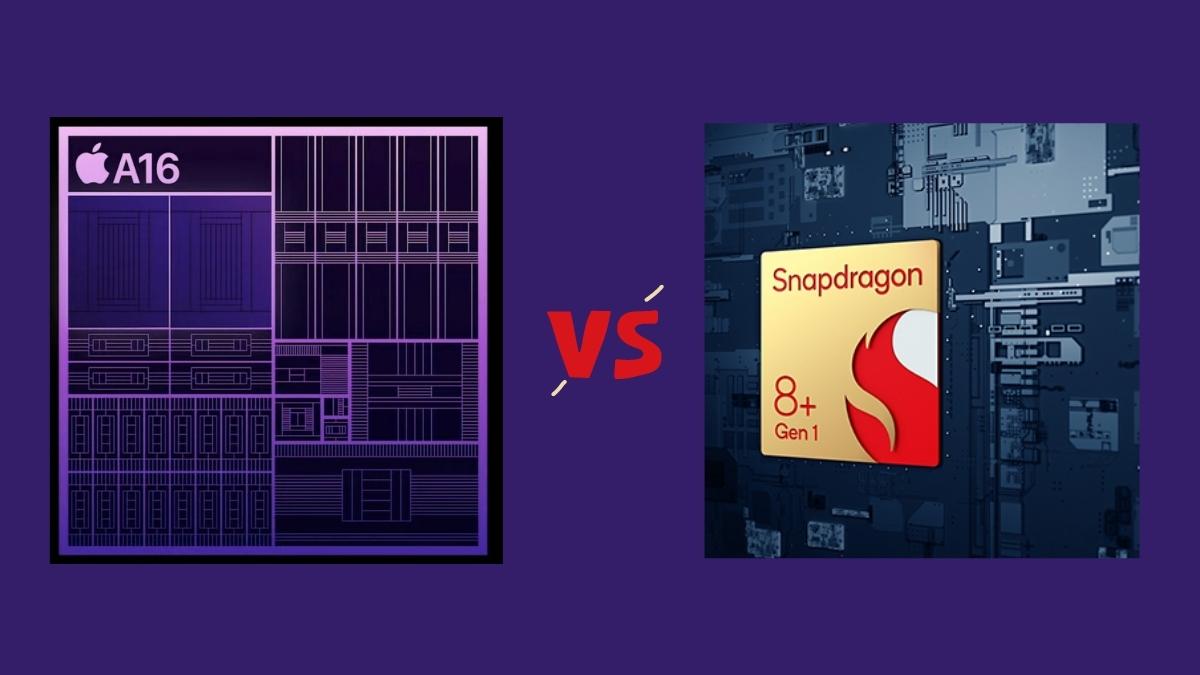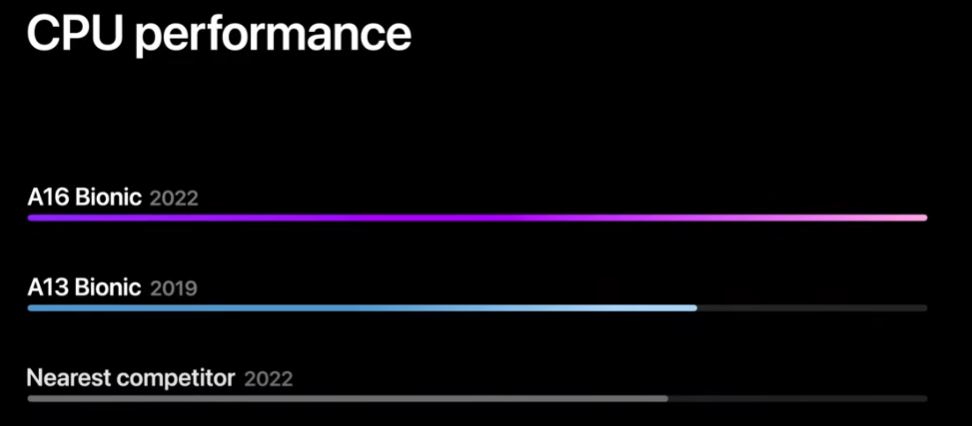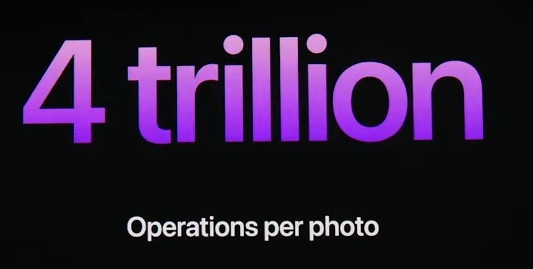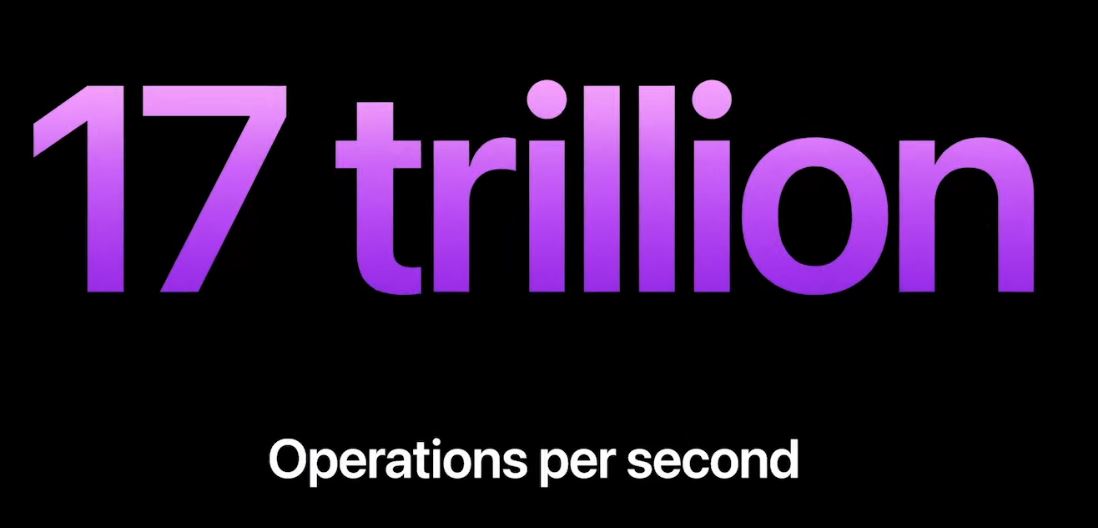Apple recently announced the A16 Bionic chip alongside the iPhone 14 Pro and iPhone 14 Pro Max. The Snapdragon 8+ Gen 1 is the fastest and most efficient chip in any Android smartphone. This post will compare the best of both worlds, i.e., the A16 Bionic and the Snapdragon 8+ Gen 1. We will review various aspects of the two flagship chips, including CPU, GPU, ISP, connectivity, and more.
Apple A16 Bionic vs Snapdragon 8+Gen 1 Comparison
The Apple A16 Bionic is the next-generation Apple silicon based on a smaller 4nm fabrication process. Apple claims they have improved the efficiency and performance of the CPU and GPU cores on the A16 Bionic chip. The A16 Bionic chip also has 16 billion transistors, which is 6.25% more than the 15 billion transistors on its predecessor.
On the other hand, the Snapdragon 8+ Gen 1 was introduced by Qualcomm earlier this year and is the most efficient Android chip so far. It is based on TSMC’s 4nm fabrication process. It has appeared in many smartphones, including the Samsung Galaxy Z Flip 4 and Z Fold 4, OnePlus 10T, iQOO 9T, and more.
1. CPU
The A16 Bionic is a hexa-core chip with two high-performance and four high-efficiency cores. The CPU consists of a total of 16 billion transistors, allowing faster data processing. The new chip is based on TSMC’s latest 4nm fabrication process, which makes it super efficient.
The Snapdragon 8+ Gen 1 is an octa-core processor. These include a powerful Cortex-X2 core clocked at 3.2GHz, three Cortex-A710 performance cores clocked at 2.5GHz, and four Cortex-A510 efficient cores clocked at 1.8GHz. The Snapdragon 8+ Gen 1 is also based on TSMC’s 4nm fabrication process, just like the Apple A16 Bionic.
During the Far Out keynote, Apple compared their 3-year-old A13 Bionic to the nearest competitor, most likely the Snapdragon 8+ Gen 1. Apple then compared the A16 Bionic to the A13 Bionic, showing a 25-30% improvement on the graph. However, this graph is based on single-core performance. The performance gap may reduce to about 10-15% in multi-core performance, which is still a lot.
Apple also claimed that the A16 Bionic’s efficiency cores consume 1/3rd the power of the nearest competitor, i.e., the Snapdragon 8+ Gen 1. Plus, Apple stated that the performance cores on the A16 Bionic are 20% more efficient than its predecessor. This makes it clear that Apple is truly focusing on efficiency with the A16 Bionic this year. Despite the negligible improvement over its predecessor, the A16 is still far ahead of the Snapdragon 8+ Gen 1.
2. GPU
As for the GPU, the A16 Bionic packs a similar 5-core GPU as its predecessor but with 50% more memory bandwidth. More memory bandwidth makes the already powerful GPU better. It can handle heavy graphics-intensive tasks without any hiccups. Besides, Apple has also included a dedicated display engine in the GPU to support the Always-On Display on the iPhone 14 Pros.
On the flip side, the Snapdragon 8+ Gen 1 rocks the Adreno 730 GPU. With support for Snapdragon Elite Gaming, volumetric rendering, HDR gaming, etc., the Adreno 730 GPU is no less powerful. Plus, it has a Frame Motion Engine that helps sustain graphics performance at higher refresh rates.
Since we do not have any benchmarks or real data about the A16 Bionic’s graphics performance, we can compare the Snapdragon 8+ Gen 1 to the A15 Bionic’s GPU apart from what Apple told us. The A15 Bionic’s 5-core GPU performs almost 50% better than the Adreno 730 GPU on the Snapdragon 8+ Gen 1. And with the improved GPU on the A16 Bionic, the performance gap will only get wider.
3. Benchmarks
A recently released GeekBench score of the model “iPhone15,3” (iPhone 14 Pro code name) reveals the GeekBench test result of the A16 Bionic. The results show a score of 1879 in single-core performance and 4664 in multi-core performance. While this may not seem like a huge difference compared to the A15 Bionic, it is clearly a huge leap compared to the Snapdragon 8+ Gen 1.
For instance, the Snapdragon 8+ Gen 1 scores 1321 in single-core performance and 4238 in multi-core performance. This makes the A16 Bionic almost 30% faster than the Snapdragon 8+ Gen 1 in single-core performance and about 10% faster in multi-core performance. The single-core performance difference matches the graph Apple used during the keynote.
4. ISP
Apple has also brought huge changes to the ISP on the A16 Bionic. For starters, Apple has designed a new ISP or Image Signal Processor only to power the new quad-pixel sensor on the iPhone 14 Pros. Apple claims that the ISP can perform 4 trillion operations per photo, providing more flexibility to the quad-pixel sensor and resulting in faster computational photography.
In addition, Apple has also introduced a new Photonic engine that helps Deep Fusion occur earlier in the process, resulting in more detailed, vibrant, and brighter images. The new ISP also supports other features like the new Action Mode that stabilizes shaky videos, ProRes, and Dolby Vision HDR.
As for the Snapdragon 8+ Gen 1, its ISP is also very powerful. The 18-bit triple ISP can capture 3.2 gigapixels per second. It can capture 8K HDR videos and capture 64MP photos without any lag. It can also shoot in 18-bit RAW and has 5X better night mode. It also has a dedicated Bokeh Engine for 4K videos, similar to the Deep Fusion on A16 Bionic. The Snapdragon 8+ Gen 1 ISP is as powerful as the one on the A16 Bionic. Everything comes down to software implementation. Therefore, there is no clear winner in this aspect.
5. AI and Machine Learning
The A16 Bionic has a new 16-core Neural Engine that can perform up to 17 trillion operations per second. This time around, the Snapdragon 8+ Gen 1 beats the A16 Bionic by a massive leap in operations per second. The 7th Gen AI Engine can perform up to 27 trillion operations per second, which is 10 trillion more operations than the Neural Engine on the A16 Bionic. The performance per watt is also lower than the A16 Bionic, making it more power-efficient. Plus, the 3rd-gen Sensing Hub on the Snapdragon 8+ Gen 1 allows for the preservation of the battery by performing low-powered AI tasks.
6. Connectivity
The Apple A16 Bionic still uses Qualcomm’s Modem for 5G connectivity instead of the rumored Apple-designed modem. The A16 Bionic supports both sub-6 GHz and mmWave 5G bands. However, the mmWave 5G bands are limited to only the US and Puerto Rico as of now. Lastly, the A16 Bionic supports the latest Wi-Fi 6E and Bluetooth 5.3.
The Snapdragon 8+ Gen 1 uses the integrated X65 5G modem, which supports the sub-6 GHz and mmWave 5G bands. However, the availability is dependent on the smartphone manufacturer. And finally, the Snapdragon 8+ Gen 1 also supports the latest Wi-Fi 6E and Bluetooth 5.3.
Which One is Better?
After discussing the differences between the Apple A16 Bionic and the Snapdragon 8+ Gen 1, it is evident that the A16 is generations ahead. It has a better CPU and GPU, and it is unclear when the Snapdragon processors will catch up. For now, the A16 is the fastest smartphone processor.







